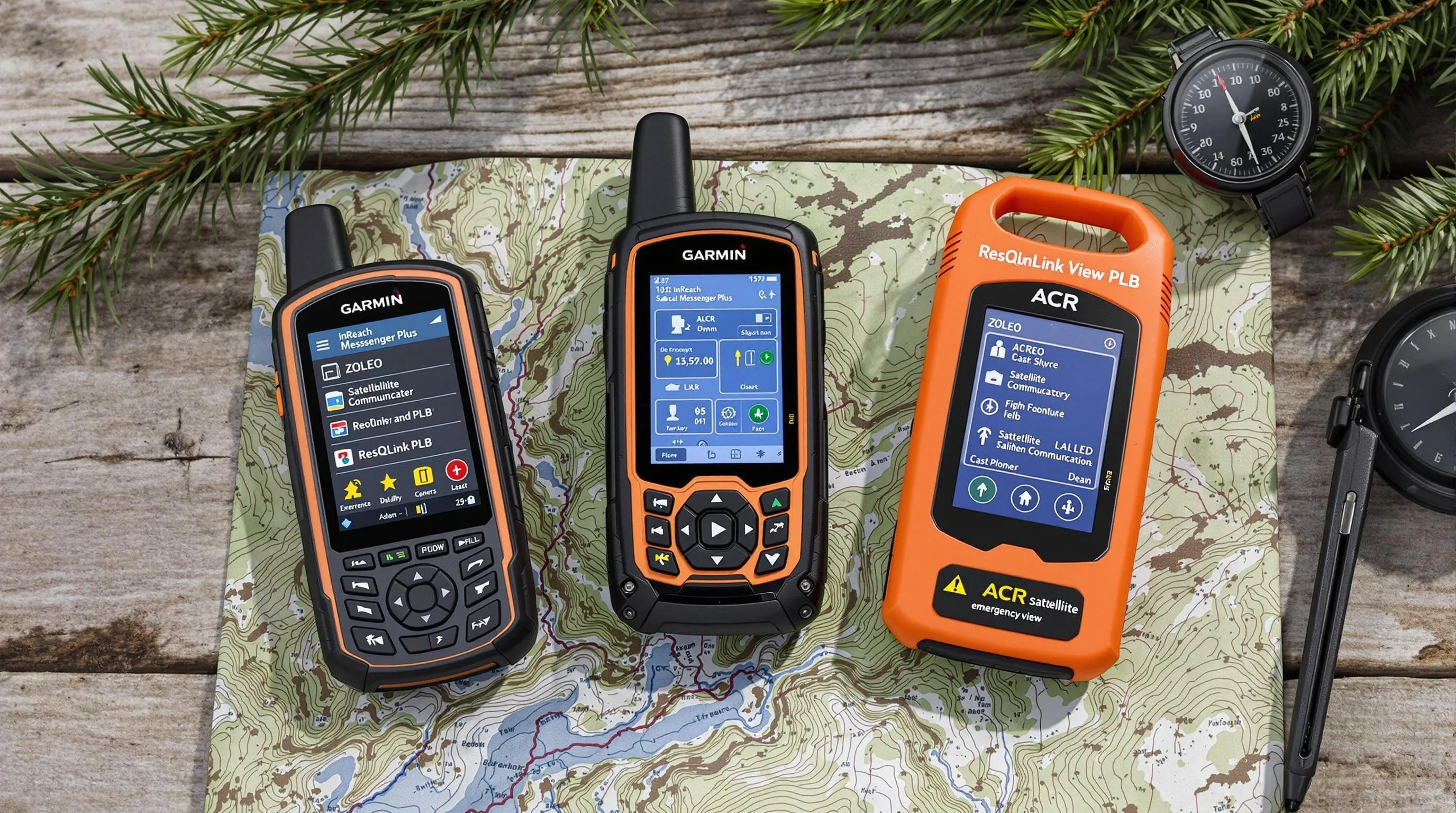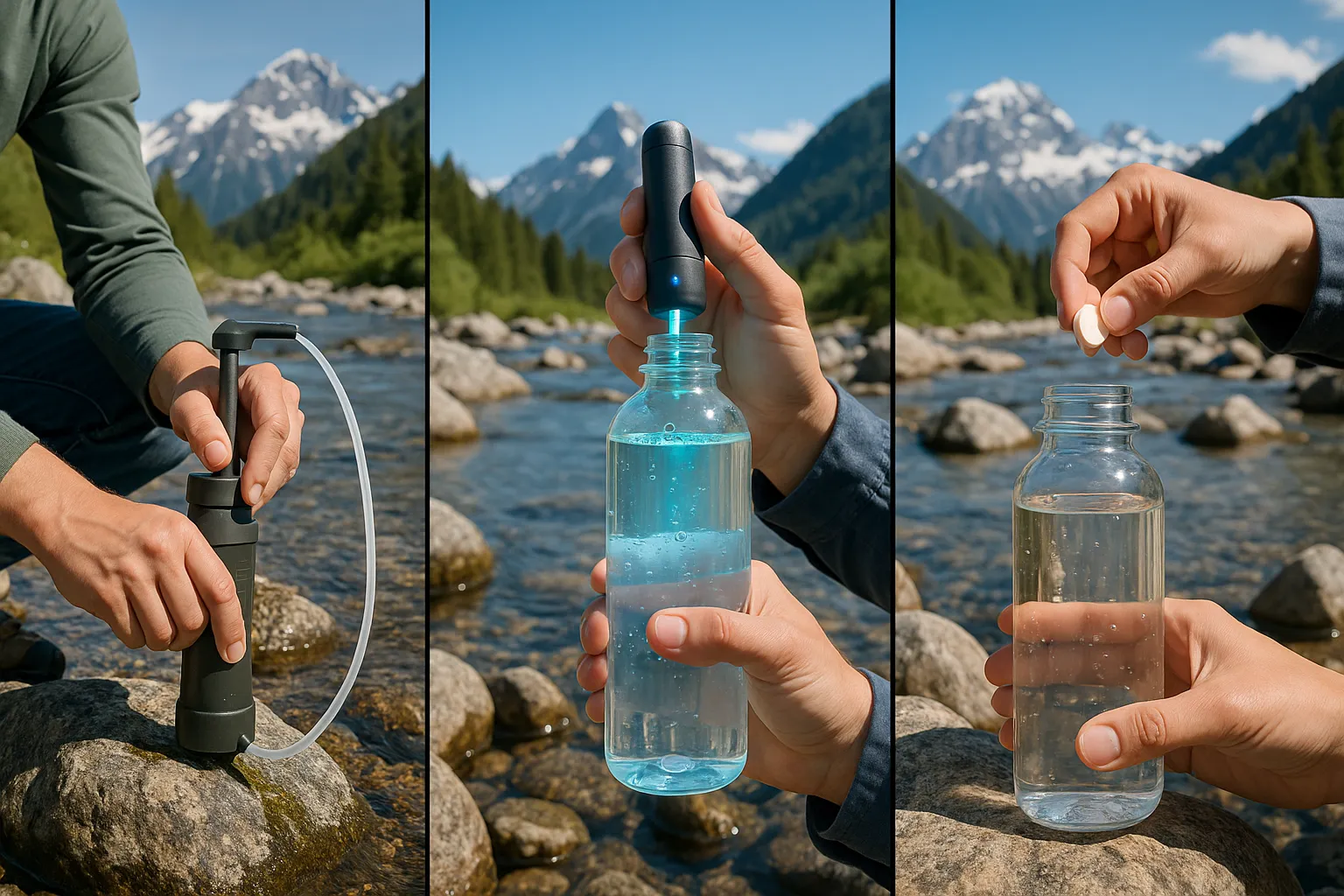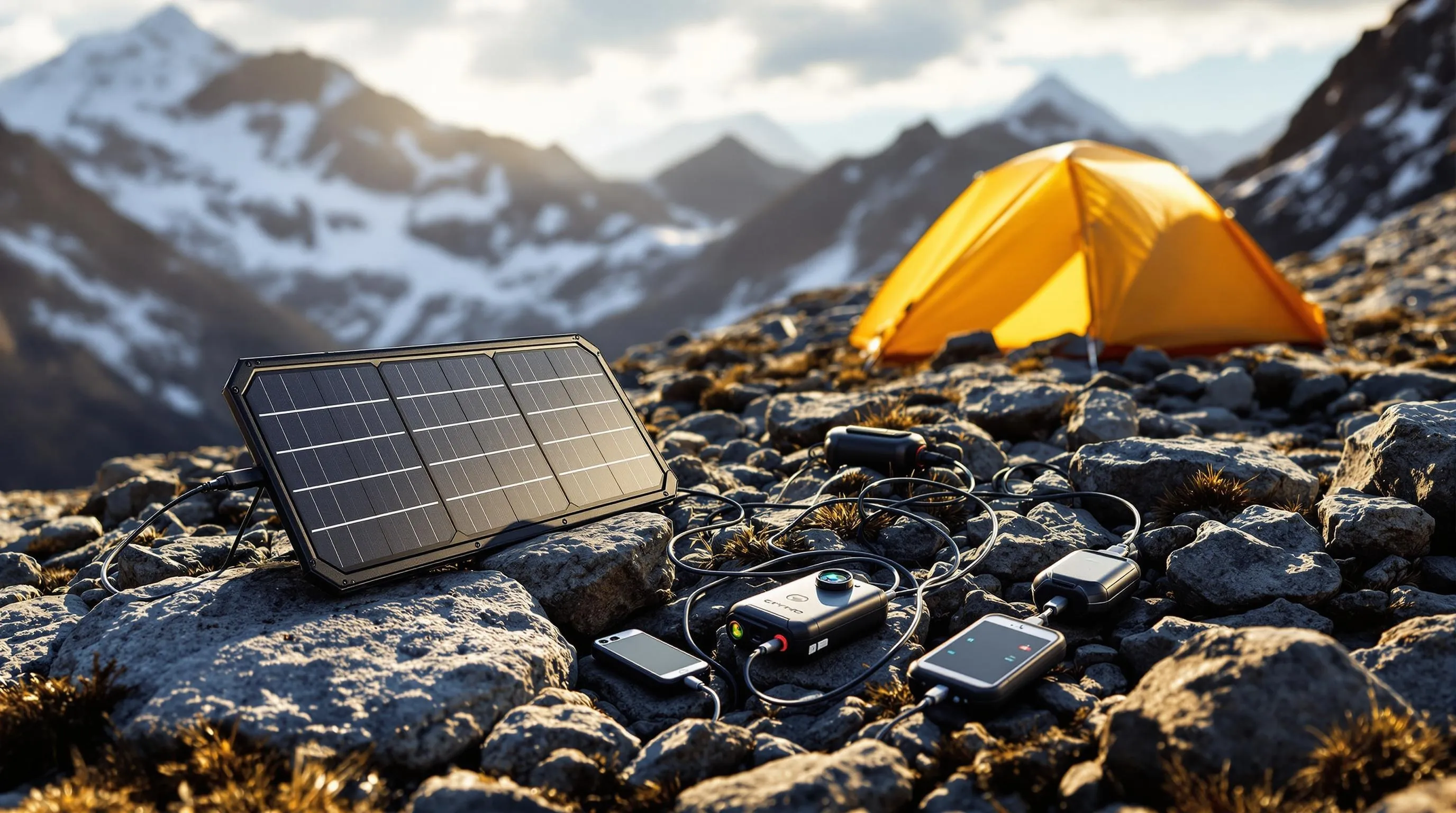
This blog post may contain affiliate links that help us maintain the website. We may earn a small commission when you make a purchase through these links at no additional cost to you.
Survival Tech: Essential Gadgets and Systems for Wilderness Safety
What happens when your smartphone has no service and your survival depends on technology that actually works in the wilderness?
According to wilderness rescue organizations, over 70% of emergency evacuations could have been prevented with proper survival tech and knowledge. Wilderness survival technology has evolved far beyond basic compasses and fire starters, offering advanced solutions specifically designed for remote environments.
This comprehensive guide covers the essential gadgets and systems that provide reliable safety nets when venturing beyond cellular coverage and conventional infrastructure. Understanding and carrying appropriate survival tech isn't just about convenience—it's about creating multiple layers of protection against potentially life-threatening situations in remote locations.
I've personally tested dozens of wilderness tech products over thousands of trail miles, and I'll share exactly which systems perform when it matters most. We'll explore seven critical categories of wilderness survival technology: communication devices, navigation systems, water purification tech, emergency shelters, weather monitoring tools, sustainable power solutions, and advanced first aid equipment.
Life-Saving Communication: Satellite Messengers and Emergency Beacons

When you venture beyond cellular coverage, reliable communication becomes your lifeline to emergency services. The technology divides into two main categories, each with distinct purposes and capabilities.
Satellite messengers and personal locator beacons (PLBs) serve fundamentally different purposes. Satellite messengers provide two-way communication, allowing you to both send and receive messages, while PLBs are designed solely for emergency situations, sending one-way distress signals to search and rescue services. This distinction is crucial when selecting the appropriate device for your adventure profile.
The leading satellite communication devices offer varying features that match different wilderness needs:
| Device | Two-Way Messaging | Weight | Battery Life | Subscription | Notable Features |
|---|---|---|---|---|---|
| Garmin inReach Messenger Plus | Yes | 4.0 oz | 28 days | $14.95-$64.95/month | Photo sharing, voice messages, weather forecasts |
| ZOLEO Satellite Communicator | Yes | 5.3 oz | 200+ hours | $20-$50/month | Seamless messaging transition between cellular/WiFi/satellite |
| ACR Bivy Stick | Yes | 3.4 oz | 120+ hours | $17.99-$49.99/month | Lightweight, Bluetooth connectivity to phone |
| Garmin inReach Mini 2 | Yes | 3.5 oz | 14 days | $14.95-$64.95/month | Compact size, standalone navigation |
| ACR ResQLink View | No | 5.4 oz | 28+ hours | None | No subscription, worldwide rescue network |
Iridium network powers most premium satellite messengers, providing truly global coverage including polar regions. The Globalstar coverage used by some budget options offers more limited service, with gaps particularly in remote wilderness areas and oceans.
For effective emergency communication in wilderness settings, follow this protocol:
- Assess the situation fully before activating emergency features
- Provide precise location details even when GPS coordinates are automatically transmitted
- Clearly communicate the nature of your emergency and resources needed
- Establish a communication schedule if two-way messaging is available
- Conserve battery power by minimizing non-essential messages
Smartphone satellite emergency features are emerging as a backup option, with Apple's Emergency SOS via satellite and Android's satellite connectivity. However, these systems remain limited in functionality compared to dedicated devices, offering basic emergency messaging without the comprehensive communication capabilities of satellite messengers.
"During my Pacific Crest Trail thru-hike, my satellite messenger allowed me to call for evacuation when my hiking partner developed severe altitude sickness. The ability to communicate our exact situation, not just our location, meant rescuers arrived with appropriate medical equipment." - Experienced wilderness guide
When to Choose a Satellite Phone

While satellite messengers are sufficient for most adventures, satellite phones become necessary in scenarios requiring voice communication, such as:
- Coordinating complex rescue operations
- Medical emergencies requiring real-time guidance
- Extended expeditions in extremely remote areas
- Professional guides responsible for client safety
- Situations where text communication might be insufficient
The trade-offs for this enhanced capability include higher cost, increased weight, and typically shorter battery life than dedicated messengers.
Loading product information...
View on AmazonLoading product information...
View on AmazonWilderness Navigation Technology: Beyond Basic GPS

Getting lost in the wilderness can quickly escalate from inconvenience to life-threatening emergency. Modern navigation technology provides multiple layers of protection against this common danger.
The evolution from basic GPS to multi-GNSS receivers represents a significant advancement in navigation reliability. While GPS (Global Positioning System) is the most well-known satellite navigation system, devices that also access GLONASS, Galileo, and BeiDou constellations dramatically improve position accuracy and reliability, especially in challenging terrain like deep canyons or dense forests.
When comparing smartphone navigation to dedicated wilderness devices, consider these crucial differences:
- Battery endurance: Dedicated devices typically offer 20+ hours of continuous navigation versus 4-8 for smartphones
- Environmental durability: Wilderness GPS units withstand extreme temperatures, submersion, and drops that would disable most phones
- Antenna sensitivity: Purpose-built receivers acquire and maintain satellite signals in challenging conditions where phones struggle
- Button operation: Touchscreens become unusable in rain, with gloves, or extreme cold; physical buttons remain functional
- Map functionality: Dedicated units come preloaded with topographic maps and specialized wilderness navigation features
Digital compasses in wilderness navigation devices incorporate declination adjustment and calibration features that significantly outperform smartphone sensors. Similarly, barometric altimeters provide elevation data regardless of satellite signal quality, helping you locate position on topographic maps when visual landmarks are unavailable.
For effective wilderness navigation technology use, implement these best practices:
- Download offline maps before departing (regardless of device used)
- Create waypoints for critical navigation points (water sources, trail junctions, escape routes)
- Establish a battery management protocol (airplane mode for smartphones, reduced backlight for dedicated GPS)
- Use track recording features sparingly to conserve battery
- Regularly check position against your intended route rather than relying solely on digital navigation
Emerging technologies like augmented reality navigation overlay directional information on real-world views through your smartphone camera, particularly useful for identifying distant landmarks or confirming trail junctions. However, these features remain battery-intensive and should supplement rather than replace traditional navigation methods.
Top Wilderness Navigation Apps
For smartphone-based navigation that functions offline:
- Gaia GPS: Most comprehensive topographic maps and trail database
- onX Backcountry: Excellent landowner boundary information for remote areas
- Avenza Maps: Supports custom map imports including specialty wilderness maps
- AllTrails Pro: User-friendly interface with extensive trail information
- CalTopo: Advanced planning capabilities used by search and rescue teams
Remember that even the best navigation technology requires fundamental map-reading skills to use effectively. The ability to correlate digital information with physical terrain features remains essential for wilderness safety.
Water Purification Tech: From UV Light to Advanced Filtration

Access to clean drinking water becomes a life-or-death concern in survival situations. Modern water purification technology offers multiple solutions for converting questionable water sources into safe hydration.
The effectiveness of different purification methods varies significantly based on the contaminants present:
| Purification Method | Weight | Bacteria | Protozoa | Viruses | Chemicals | Notable Features |
|---|---|---|---|---|---|---|
| Mechanical Filtration | 2-16 oz | ✓✓✓ | ✓✓✓ | ✗/✓* | ✗/✓* | Immediate use, no chemicals, *varies by filter type |
| UV Purification | 2-5 oz | ✓✓✓ | ✓✓✓ | ✓✓✓ | ✗ | Fast treatment, requires batteries, clear water only |
| Chemical Treatment | <1 oz | ✓✓ | ✓✓ | ✓✓ | ✗ | Lightweight, wait time required, alters taste |
| Boiling | 0 oz† | ✓✓✓ | ✓✓✓ | ✓✓✓ | ✗ | †Requires stove/fuel, time-consuming, fuel-intensive |
| Gravity Filtration | 10-16 oz | ✓✓✓ | ✓✓✓ | ✗/✓* | ✗/✓* | Effortless for groups, slower initial setup |
Micron ratings directly correlate to pathogen protection capabilities. Most bacteria measure 0.2-10 microns, while protozoan cysts like Giardia and Cryptosporidium range from 1-15 microns. Viruses, at 0.004-0.1 microns, pass through standard filters, requiring specialized purification methods.
Hollow fiber membrane technology has revolutionized portable water filtration, using microscopic tube structures with precisely-sized pores to physically block pathogens while allowing water molecules to pass through. These systems offer exceptional filtration with minimal moving parts, increasing reliability in field conditions.
Maintaining your water purification system properly is essential for both effectiveness and longevity:
- Backflush mechanical filters after every trip or when flow decreases
- Protect filter elements from freezing, which can create microscopic cracks
- Store chemical treatments in appropriate temperature conditions
- Replace UV lamp components according to manufacturer specifications
- Carry mechanical cleaning tools appropriate for your specific filter
Newer portable technologies like handheld water quality testers provide real-time analysis of bacterial load and chemical contaminants, helping you select appropriate treatment methods for specific water sources. While currently expensive for individual use, these devices are becoming increasingly accessible to wilderness guides and group expeditions.
When primary purification methods fail, knowing emergency alternatives becomes crucial:
- Solar water disinfection (SODIS): Fill clear plastic bottles and expose to direct sunlight for 6+ hours
- Improvised charcoal filtration: Layer charcoal from campfire with sand and gravel to reduce particulates and some contaminants
- Natural sedimentation: Allow water to stand for 24+ hours to settle particulates before careful decanting
Remember that no improvised method guarantees pathogen removal, making proper water purification technology one of your most important survival investments.
Survival Shelter Technology: Advanced Protection from the Elements
In extreme conditions, shelter technology can make the difference between life and death. Modern materials have dramatically improved emergency shelter options, providing superior protection at minimal weight and volume.
Emergency shelter technologies offer varying levels of protection, setup complexity, and portability:
| Shelter Type | Weight | Setup Time | Heat Retention | Weather Protection | Reusability |
|---|---|---|---|---|---|
| Space Blanket | 1-3 oz | <1 min | ★★☆ | ★☆☆ | Limited |
| Emergency Bivy | 3-8 oz | 1-2 min | ★★★ | ★★☆ | Moderate |
| Ultralight Tarp | 8-16 oz | 3-10 min | ★☆☆ | ★★☆ | Excellent |
| Survival Tent | 8-32 oz | 2-5 min | ★★★ | ★★★ | Good |
Material innovations have revolutionized survival shelter design. Mylar (polyester film with metallized coating) offers exceptional heat reflection properties, retaining up to 90% of body heat when properly deployed. Silnylon (silicone-impregnated nylon) provides remarkable waterproofing at minimal weight, while Dyneema Composite Fabric delivers unmatched strength-to-weight ratio for durability in extreme conditions.
Heat reflective coatings work by creating a vapor barrier that prevents both moisture loss and heat escape. This technology is particularly effective when the reflective surface faces your body, but requires careful moisture management to prevent condensation buildup inside the shelter.
For emergency shelter deployment in adverse conditions:
- Select location carefully, prioritizing protection from wind and water runoff
- Create insulation layer between your body and the ground when possible
- Position entrance away from prevailing wind
- Secure shelter against unexpected wind gusts
- Maintain adequate ventilation to balance heat retention with moisture management
Emerging technologies in rapid-deployment shelters include self-inflating structures that erect in seconds using integrated air channels and shape-memory materials that automatically expand into predetermined forms when removed from their storage container. While currently expensive, these technologies are becoming increasingly accessible for wilderness adventurers.
"After becoming separated from my group during unexpected weather changes in the Cascades, my emergency bivy shelter allowed me to survive a night of near-freezing temperatures and unexpected snowfall. The material's heat reflection capabilities prevented hypothermia until search teams located me the following morning." - Wilderness Search and Rescue volunteer
Emergency Shelter Selection Factors
When selecting emergency shelter technology, prioritize:
- Appropriate protection level for typical environmental threats in your adventure areas
- Realistic setup capabilities considering likely emergency scenarios (injury, darkness, severe weather)
- Packability metrics that ensure you'll actually carry the shelter on every trip
- Durability appropriate to your emergency scenario (hours vs. days of protection)
- Visibility features that aid search teams (bright colors, reflective elements)
Remember that even the most advanced shelter technology requires basic site selection skills to maximize effectiveness. Understanding natural wind breaks, drainage patterns, and insulation principles remains essential for wilderness safety.
Loading product information...
View on AmazonWeather Monitoring and Prediction Tools for the Backcountry
Unpredictable weather represents one of the most significant hazards in wilderness environments. Technology now provides portable options for monitoring, predicting, and responding to changing weather conditions far from civilization.
Portable weather stations have become increasingly sophisticated while decreasing in size and power requirements. Modern devices combine multiple sensing capabilities:
- Barometric pressure for trend monitoring and short-term forecasting
- Temperature and humidity for heat index and hypothermia risk assessment
- Wind speed and direction for storm movement prediction
- Precipitation type and intensity measurement
- Lightning detection for strike distance and frequency monitoring
Interpreting barometric pressure trends provides one of the most reliable methods for short-term weather prediction in remote areas. A steady drop in pressure (typically 0.18 inHg or more over three hours) generally indicates approaching storms. Conversely, rising pressure typically signals improving conditions. The rate of change often correlates directly with the severity of approaching weather systems.
Millibars (mb) and inches of mercury (inHg) are common units for measuring barometric pressure, with rapid pressure decline (exceeding 0.06 inHg/hour) serving as a key warning sign for severe weather development.
Lightning detection technology has become particularly valuable for wilderness safety. Portable detectors can identify strike distances up to 40 miles away using radio frequency monitoring, providing crucial warning time before storms arrive at your location. Advanced models offer directional information to help determine storm movement relative to your position.
For effective weather monitoring in the backcountry:
- Establish baseline readings upon arrival at your location
- Check readings at consistent intervals (every 1-3 hours in changing conditions)
- Note trend directions and rates rather than focusing solely on absolute values
- Correlate instrumental readings with visual observations of cloud formations
- Make conservative decisions when readings indicate potential deterioration
Satellite weather receivers provide another layer of information by accessing weather data broadcasts directly from weather satellites or ground-based transmitters. These specialized devices, while more expensive, offer detailed forecast information and weather graphics without requiring cellular connectivity.
Decision Tree for Severe Weather Risk Assessment
When monitoring indicates potential severe weather:
- Are you in an exposed location? (ridge, peak, open water)
- Yes → Move to lower, more protected terrain immediately
- No → Continue assessment
- Is lightning detection showing nearby strikes?
- Yes → Implement lightning position protocol immediately
- No → Continue assessment
- Is barometric pressure dropping rapidly?
- Yes → Begin moving toward safer location/shelter
- No → Continue monitoring at increased frequency
- Are visual indicators showing thunderstorm development?
- Yes → Assume lightning risk and seek appropriate position
- No → Continue monitoring while preparing contingency plans
Smartphone-based weather prediction tools have improved significantly, with several options providing valuable offline capabilities:
- Windy: Exceptional wind and precipitation visualization with downloadable forecast packages
- Weather Underground: Detailed forecasting with historical data comparison
- NOAA Weather Radio: Emergency alerts and official forecasts
- MeteoEarth: Advanced visualization of weather patterns and systems
- Dark Sky API (integrated into various apps): Hyperlocal precipitation forecasting
Remember that even the best weather technology provides probabilities rather than certainties. Combining technological monitoring with traditional weather sign observation and conservative decision-making creates the most effective approach to weather safety in wilderness settings.
Sustainable Power Solutions: Keeping Your Tech Alive in the Wild

Your survival tech is only as reliable as its power source. Modern portable power solutions offer multiple options for maintaining critical devices during extended wilderness adventures.
Different power generation and storage options provide varying benefits and limitations:
| Power Solution | Weight | Daily Output | Environmental Factors | Best Application |
|---|---|---|---|---|
| Solar Chargers | 7-28 oz | 5-21 Wh | Requires direct sunlight | Extended trips with reliable sun |
| Power Banks | 6-20 oz | 25-74 Wh (total) | Temperature sensitive | Short trips, cold weather |
| Hand-Crank Generators | 7-16 oz | 2-5 Wh | Requires physical effort | Emergency backup only |
| Fuel Cell Chargers | 8-17 oz | 10-14 Wh | Requires fuel cartridges | Reliable power regardless of conditions |
Power requirements vary significantly between survival devices. A satellite messenger might consume 0.5-1.5 Wh daily with typical use, while a smartphone used for navigation could require 10-15 Wh daily. Understanding these requirements allows proper power planning for your specific device ecosystem.
Pass-through charging capability allows devices to both receive and deliver power simultaneously, creating more efficient charging workflows. Similarly, peak power tracking technology in advanced solar chargers automatically adjusts voltage and amperage to maximize energy harvest as light conditions change.
Environmental conditions dramatically impact charging efficiency:
- Solar panels typically deliver only 50-60% of their rated output in real-world conditions
- Power banks lose 20-30% capacity in near-freezing temperatures
- Hand-crank generators require 2-3× more cranking time at high altitudes
- All systems perform less efficiently in extreme heat (above 95°F/35°C)
For effective power management on extended wilderness trips:
- Prioritize critical safety devices over convenience electronics
- Implement aggressive power conservation (airplane mode, minimal screen time)
- Charge opportunistically whenever conditions are favorable
- Keep batteries warm in cold conditions (sleep with them in your sleeping bag)
- Establish charging hierarchy based on device importance and charging efficiency
Emerging technologies in portable power include flexible solar panels that conform to backpack surfaces for charging while moving and thermoelectric generators that convert heat differential (between campfire and ambient air) into usable electricity. While currently expensive and somewhat specialized, these technologies offer promising alternatives for future wilderness power generation.
"During my month-long expedition in Patagonia, my 21W solar charger kept my satellite messenger, headlamp, and GPS functioning despite variable weather conditions. The ability to maintain communication and navigation capability throughout the trip provided essential safety margin in this remote region." - Professional wilderness guide
Weight-to-Power Analysis
When selecting portable power solutions, consider these weight-to-power ratios:
- Lithium power banks: Approximately 9-12 Wh per ounce
- Solar chargers: Approximately 0.5-0.75 Wh per ounce per day (good conditions)
- Hand-crank generators: Approximately 0.2-0.3 Wh per ounce per day
- Fuel cell systems: Approximately 0.8-1.0 Wh per ounce per day (including fuel)
This analysis highlights why most wilderness travelers rely primarily on power banks for short trips (1-3 days), transitioning to solar or fuel cell options for extended backcountry adventures.
Wilderness Medical Tech: Advanced First Aid for Remote Emergencies
Medical emergencies in remote wilderness settings present unique challenges that specialized technology can help address. These tools extend diagnostic capabilities and treatment options when professional medical care is hours or days away.
Portable diagnostic tools designed for wilderness medicine have evolved significantly in recent years:
- Digital thermometers with waterproof, shock-resistant construction
- Pulse oximeters for monitoring blood oxygen levels at high altitude
- Blood pressure monitors with wilderness-specific reference ranges
- Blood glucose meters ruggedized for field conditions
- Portable ECG monitors for cardiac assessment in remote settings
Telemedicine options increasingly work with limited connectivity, using compressed data transmission protocols that function even with intermittent or minimal bandwidth. These systems allow consultation with emergency medicine professionals to guide treatment decisions when evacuation is delayed or complicated.
Pulse oximetry provides crucial data for managing high-altitude illnesses, while automated external defibrillators specifically designed for wilderness use offer potentially life-saving intervention for cardiac emergencies.
Advanced wound care technologies for remote settings include:
- Hemostatic agents that rapidly stop severe bleeding
- Advanced closure systems that replace traditional suturing
- Antimicrobial field dressings that reduce infection risk
- Vacuum-assisted wound therapy adapted for wilderness scenarios
- Specialized burn treatment materials optimized for delayed evacuation
For effective wilderness first aid kit organization with technological components:
- Create modular systems organized by injury/illness type
- Store electronic devices with extra batteries or charging solutions
- Include printed backup references for when electronics fail
- Properly label medications with wilderness-relevant dosing information
- Regularly check expiration dates and device functionality
Emerging technologies in portable medical diagnostics include ultracompact ultrasound devices that connect to smartphones and artificial intelligence-assisted diagnostic tools that help identify conditions based on symptom patterns. While currently at the frontier of wilderness medicine, these tools are increasingly being adopted by professional guides and expedition doctors.
Tech-Enhanced Wilderness First Aid Kit
A comprehensive wilderness medical kit with technological components should include:
- Digital thermometer (waterproof, shock-resistant)
- Pulse oximeter (especially for high-altitude travel)
- Blood pressure cuff (manual or automatic)
- Smartphone with offline medical reference apps
- Satellite communication device with medical consultation capability
- Medication tracking system with dosing schedules
- Specialized wound care materials
- Water purification technology (for medical applications)
- Medical-grade adhesive products
- Medication preservation tools for temperature-sensitive items
Remember that even sophisticated medical technology requires proper training to use effectively. Wilderness first aid certification provides the foundation necessary to appropriately deploy these advanced tools in emergency situations.
Creating Your Personal Wilderness Survival Tech System
Wilderness survival technology is most effective when selected, configured, and deployed as an integrated system rather than individual gadgets. The right approach balances redundancy with practicality while accounting for your specific adventure profile.
Redundancy is the cornerstone of effective wilderness survival technology—always have backup systems for critical functions. This doesn't necessarily mean carrying two identical devices, but rather having alternative methods for essential capabilities like navigation, communication, and water purification.
The best survival tech balances four crucial factors:
- Reliability: Will it function when needed in challenging conditions?
- Durability: Can it withstand the environmental stresses of wilderness travel?
- Simplicity: Can you operate it effectively under stress or in adverse conditions?
- Weight efficiency: Does its utility justify the weight in your pack?
Technology enhances but should never completely replace fundamental wilderness skills. Each piece of survival tech should complement your knowledge rather than substitute for it. Understanding how to navigate with map and compass, purify water through multiple methods, and recognize weather patterns provides essential backup when technology fails.
Regular testing and familiarity with your gear before critical situations is essential. Practice using your satellite communicator's emergency functions (in test mode), setting up your shelter in challenging conditions, and navigating with your devices in areas with known locations. This hands-on experience builds competence and reveals potential issues before they become life-threatening in real emergencies.
A systematic approach to selecting and using survival tech creates multiple layers of protection against wilderness hazards. Consider building your system around these core principles:
- Communication redundancy: Primary satellite device and backup emergency signaling option
- Navigation layering: Digital system, map/compass skills, and terrain recognition abilities
- Water security: Multiple purification methods appropriate to regional water hazards
- Environmental protection: Shelter options suitable for area-specific weather extremes
- Power independence: Charging solutions matched to device requirements and trip duration
I encourage you to evaluate your current wilderness technology systems for gaps or single points of failure. What happens if your primary device fails? How will you adapt if conditions exceed your equipment's capabilities?
Practice using your survival tech in controlled environments before relying on it in emergencies. Many wilderness accidents occur when users can't effectively operate their equipment under stress or adverse conditions.
Create a personalized survival tech checklist based on your typical adventure profiles and risk assessment. This systematic approach ensures consistent preparation regardless of trip-planning time constraints.
Schedule regular maintenance and testing dates for critical survival technology. Battery degradation, software updates, and physical wear can compromise performance without regular attention.
The right wilderness survival technology creates not just safety but peace of mind for both adventurers and their loved ones. By thoughtfully integrating appropriate technology with solid outdoor skills, you create a foundation for confident exploration beyond the boundaries of civilization.